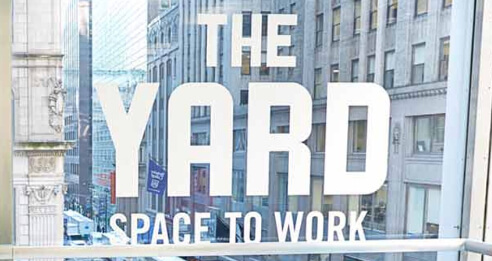
Largest Coworking Companies


By now, you've already heard about coworking. But there's a new concept on the way: Co-living, which is, in a sense, the coworking equivalent of finding housing. A trend that's been quickly embraced by young people in cities across the country, co-living is a new answer to the age-old issue of affordable housing. It's also an ideal way to continue your professional and personal growth outside of the office.
While co-living may seem like a foreign concept, it might be the perfect way to find a community that's just right for you.

Co-living means living with many other people in one space that encourages its residents to interact and work together. These spaces have popped up in response to the huge number of young people moving to expensive cities in search of work. Overall, co-living is a new kind of modern housing arrangement where residents with shared interests, intentions, and values share a living space where they're almost like a big family.
Co-living is built on the concept of openness and collaboration, with the residents often sharing similar philosophical values. This form of housing is based on the sharing economy: Residents will usually have their own bedroom and bathroom but will share common areas like cooking and living spaces. On a practical level, the expenses are shared between all the residents. This can make it a more economical choice; the price you pay for a co-living space will vary depending on the city you live in, but it will always be cheaper than traditional rent.
While you might be imagining a hostel, dorm, or hippie commune, this version of communal living is designed with young, working professionals in mind. While it could feasibly work anywhere, it remains a mostly urban trend at the moment, with residents sharing a house, building, or apartment that's usually owned and run by a company.

Co-living and coworking are similar in terms of more than just their names. They're both based on collaboration and community and take a novel approach to daily activities, whether it's how we live or how we work. Many coworking spaces like WeWork are now adding co-living to their options, and a great deal of the co-living spaces around the world include coworking as well.
While they are not the same concept, they share key aspects that skew towards young users. They're also both poised to completely reinvent the way we think about working and living.
Many co-living establishments will double as a coworking space. For those who are digital nomads or remote workers, this is an ideal situation as quality Wi-Fi and a place to work are located right there within the space.
Coworking and co-living are also similar because of the ease with which members and residents can network. Both environments allow you to meet with similarly minded people and form relationships. These types of spaces will often have regular organized activities or events where you can naturally integrate with others. Many people opt to work in a coworking space rather than a coffee shop or at home because they want that sense of community—the same reason why people choose to live in a co-living space.

The rise of co-living stems from a variety of factors, including engaging amenities and the enjoyment of living with others who share similar interests. Unlike some communes, those who choose co-living do not separate themselves from the world outside of their living space; they interact normally with the world while choosing to live with like-minded individuals. For this reason, co-living options have been spreading across the world. There are co-living spaces in the United States as well as in cities around the globe, with several companies offering multiple locations.
Its popularity also comes from the fact that many people want to be around others and form connections. In a co-living space, it's easy to just open your door and start a new friendship—or even a business. Other benefits include a reduced financial burden, community support, group activities, and a sense of belonging. Co-living currently appeals mostly to younger generations, especially digital nomads who want to be able to travel without worrying about a mortgage or lease. This type of lifestyle has a heavy emphasis on agility; the ability to move from place to place without being tied down is freeing to some people.
Additionally, co-living spaces solve many of the problems that digital nomads and millennials face. When moving to a new city, the norm for most is to sign a one-year lease, fill the space with furniture, set up all the utilities, and when the year is up, either move or renew the lease. With co-living spaces, though, there is often no lease agreement or minimum commitment, making it a good fit for people moving from city to city due to professional or personal reasons.
Other benefits of co-living are that often there is no security deposit, and you will never have to set up utilities. Because of the communal nature of the housing arrangement, all of the resources are pooled together, so expenses are paid for as a group. One last pro to co-living spaces is that many are already furnished, so you won’t have to hire movers or spend money on furniture. Plus, while living in a co-living space you might experience enhanced productivity, especially if there's a coworking space available in the area.

There are now hundreds of co-living spaces of all shapes and sizes around the world. The Collective, founded in 2012, offers both co-living and coworking in London and New York City. They offer spaces that feature a number of amenities, like movie theaters, libraries, gyms, and even restaurants, plus a shared kitchen on every floor. Sun and Co., another co-living space, is based out of Javea, Spain in a 19th-century home with the option of shared or private rooms.
Some companies are a bit larger and boast multiple locations. For example, Roam operates outposts around the world in London, Bali, Miami, Tokyo, and San Francisco. All rooms come with private bathrooms and include cleaning services. Common offers a similar deal in nine U.S. cities. There's also WeLive, WeWork's co-living brand, which offers communal spaces in New York and D.C. that provide a solution somewhere between hotels and apartments: Tenants can stay for a few nights or for months at a time.
Services that connect users with co-living spaces have also popped up in recent years. Berlin-based Medici Living raised $1.1 billion last year to beef up its co-living platform. Similarly, CoWoLi tailors its services to digital nomads who want to travel the globe and need help finding the right co-living space. There are also a number of companies starting to invest in expanding co-living to the United States, like Quarters Holding and Khosla Ventures.

A look into the future of Coworking Spaces
The co-working market is about to be disrupted. Let's see how
Co-living spaces are just starting out, and the concept is still completely new to many people. Concerns regarding safety, scams, and practicality are prevalent— and completely valid. Keep in mind, though, that new concepts can become the standard: Airbnb, for example, was considered odd until it disrupted the entire hospitality industry. While each space varies, as long as you do your research before settling in somewhere, you should be fine.
Look up each company you're considering to ensure that they have an active website and that they are a legitimate business. When visiting potential living spaces, take time to explore and imagine how you would feel coming home to it every day. Consider the specifics, especially if you prefer a private room, an open kitchen, or amenities like a gym or a pool. Meet and chat with people who live there to find out their interests and how they like co-living at the property. With proper due diligence, you'll get a good sense of whether a place is safe and the right fit for you.
With housing costs continuing to rise, especially in urban areas, the traditional concepts of renting and buying are changing. On top of this, millennials are often the most common demographic to gravitates towards co-living spaces, due in part to the general consumer trends towards a sharing economy. In today's day and age, it seems that co-living has become more than just a housing model; it has become a solution for growing younger generations.
Save your community manager 41 hours each week—learn how The Yard did it with cloud-based access control.
Read the Case StudyThe Guide to Make Your Space More Profitable
Including interviews with experts and consultants.
Free access to our best guides, industry insights and more.
